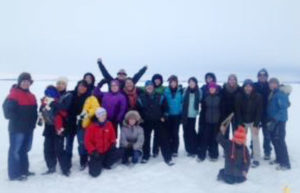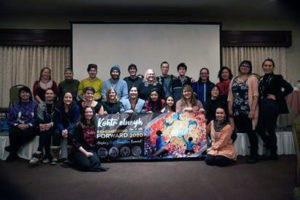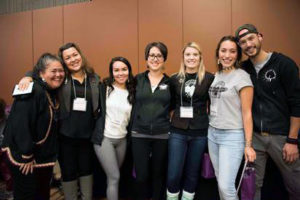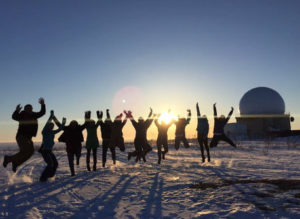Kotzebue and Native Voices Case Study
For more than 10,000 years, Alaska Natives have served as stewards and caretakers for the lands and waters to which they belong. This reciprocal relationship is based on respect, honor, and spiritual balance. However, in modern days, this stewardship and caretaking has been challenged by multi-layered governance structures, extractive industries, the removal of people from their traditional lands, and the criminalization of practicing traditional ways of life.
 This has resulted in an imbalance in the ecosystem, and Alaska’s Indigenous peoples are looking for ways to restore balance. What does “Just Transition” mean through the lens of Indigenous people? It means revitalizing the Indigenous worldviews that have been colonized, assimilated, and stolen from traditional societies and cultures.
This has resulted in an imbalance in the ecosystem, and Alaska’s Indigenous peoples are looking for ways to restore balance. What does “Just Transition” mean through the lens of Indigenous people? It means revitalizing the Indigenous worldviews that have been colonized, assimilated, and stolen from traditional societies and cultures.
In April 2016, a large group of Alaska Natives, buzzing with excitement, gathered in Kikiktagruk, the traditional Iñupiaq name for the community otherwise known as Kotzebue, a small town in Northwest Alaska. Kikiktagruk is a traditional hub for the region, with three major river systems draining into the Kotzebue Sound: the Noatak River, Kobuk River, and Selawik River. The participants of this gathering were united by a common goal: to find ways to align Native knowledge, values, and ways of being with governance structures and regulatory systems impacting their daily lives. The room held policy experts, artists, stewards of the lands and waters, traditional healers, elders, and many young Alaska Natives, all ready to shift a Western system to be accountable to traditional values of Alaska Native societies.
Kotzebue Retreat
The 25 Alaska Natives who came together at this retreat focused on the principle of creating a system that would support their well-being. They identified five separate elements that embody what a Just Transition framework looks like:
- Be Well: Indigenous wellbeing founded on respect and understanding
- Be Grounded: Indigenous Education for All
- Be Sacred: Honor and Defend Indigenous Spirituality
- Be Sustained: Sustainable Economies of Place Founded on Respect
- Be Heard: Amplify Indigenous Voices
- Be Seen: Media and Messaging by Indigenous Artists
 The group discussed each of these topics in detail and identified possible ways to move toward the goals of uplifting and strengthening these existing elements in their communities for holistic well-being.
The group discussed each of these topics in detail and identified possible ways to move toward the goals of uplifting and strengthening these existing elements in their communities for holistic well-being.
Some of the answers came quickly and concretely, such as the focus of the Be Heard discussion. The vision that emerged was to create a new political party, called “The 10k Party”: an Indigenous political movement based on core Indigenous values. The strategy included forming a tribal PAC for fundraising, forming a voter PAC for voter alignment, educating Native voters, engaging with youth, and other activities.
The group had a chance to think through each of the five elements. When discussing ways to Be Grounded, for example, the group envisioned many different ideas, such as creating hands-on outdoor learning opportunities; using cultural traditions, like dancing and weaving, to bring Indigenous values into the classroom; and having an Alaskan Native language speaker in every school in Alaska.
Along with the opportunities, many challenges rose to the surface as well. There were questions about how to change a system that has not changed in generations; how to take control of the narrative so that history is not taught through a lens of imperialism and cultural appropriation; and how to include all people, not just Alaska Natives, in this new path to learning, so that everyone can be grateful for the world we live in and the contributions of Indigenous people.
While some conversations led to very specific next steps, and some conversations resulted in the need for more discussion, participants left the room feeling excited about the possibility of building a system that serves all Alaskans equally. Everyone who participated in the retreat took time out of their fully committed lives, jobs, and families to be a part of a change. The conversations and relationships are what will breathe life into positive social change.
Native Vision and Just Transition
Following the 2016 retreat in Kikiktagruk, volunteers chose the name Native Vision under which to organize. Native Vision is directed by the leadership and guidance of a 15-member steering committee to facilitate an Alaska Native statewide grassroots movement to protect Native ways of life and promote the wellbeing of Alaska Native peoples.
 The Just Transition movement is sweeping across the country as community members attempt to move from an extractive economy to a regenerative economy while returning economic, political, and social power to community members themselves. The movement is especially necessary in Alaska among Native communities whose stewardship maintained healthy waters and lands for millennia; in order for the Just Transition movement to be effective in Alaska, it must be defined by traditional, Indigenous views.
The Just Transition movement is sweeping across the country as community members attempt to move from an extractive economy to a regenerative economy while returning economic, political, and social power to community members themselves. The movement is especially necessary in Alaska among Native communities whose stewardship maintained healthy waters and lands for millennia; in order for the Just Transition movement to be effective in Alaska, it must be defined by traditional, Indigenous views.
Heather Kendall-Miller, a leader, tribal lawyer and member of the Native Vision steering committee, emphasized the need for Indigenous voices in the movement for a Just Transition. “I think that the voices of Indigenous people in a Just Transition are essential, because Indigenous people have always had a closer connection to the land that requires sustaining,” she said. “The stories and the narratives shared by Indigenous people can speak power to truths that are a necessity. Having a healthy planet, coming to terms with the challenges that we face as a nation built on corporate greed and a world economy, and finding a way to transition beyond that and deal with the larger challenges—climate change and poverty—are the most important things we can do in this moment.”
Next Steps
April 2020 will mark four years since the initial gathering that led to the development of Native Vision. A lot has happened during this time, including the incorporation of Native Peoples Action (NPA), a statewide 501(c)(4), as well as Native Peoples Action Community Fund (NPACF), a statewide 501(c)(3) formerly known as Native Vision. NPA’s mission is to take a stand, work together, and mobilize action to ensure Alaska Natives are heard in all levels of policy making and to transform social and political systems. NPACF’s mission has remained true to the founding documents written from the Kotzebue gathering and continues to work toward advancing the transition to a just society that provides for the continuation of Alaska Native ways of life and the wellbeing of Alaska Native peoples. Both of these organizations listen to and directly respond to the needs of Alaska Native communities as they align with the shared mission of protecting Alaska Native ways of life while simultaneously uplifting communal wellbeing. Some of the ways this work is being done is through advocacy, education and awareness, strengthening public policy and programming, diversifying government, increasing involvement in decision making processes, and engaging youth.
Andrea Akall’eq Sanders (Yup’ik), a founding member of both organizations and NPA board president, comments on the work of Native Peoples Action:
We recognize the gap in Native representation in our statewide elected leadership. For us, this reality is troubling. A lack of equitable representation means that decisions are being made for us, not with us. So we came together, as community activists and doers, action focused and with our collective well-being at the center, founded Native Peoples Action. To fill this gap and work to cultivate and support grassroots candidacies, campaigns, allies and those involved with movement making for a just and equitable future. Our vision requires us to come together to redefine economic and political power within Alaska, and then work together to lift up and support candidates who can lead us, and bring others along, toward a new vision for Alaska—founded on our traditional values.
Social and economic suppression, racial inequity, and other pressing forces largely keep Indigenous stories and solutions out of reach and in the dark—even when desperately needed. Overcoming this requires fearless leaders who understand how to utilize and build strong networks, how to cultivate community partners, advance healing, wellness and restoration of lands, waters, animals, and people through a cultural lens, to share and champion what can be passed on from Indigenous and Tribal Elders, mentors, natural environmentalists and those who carry geographic intelligence, moving us forward into the future. That is what NPA is all about.

